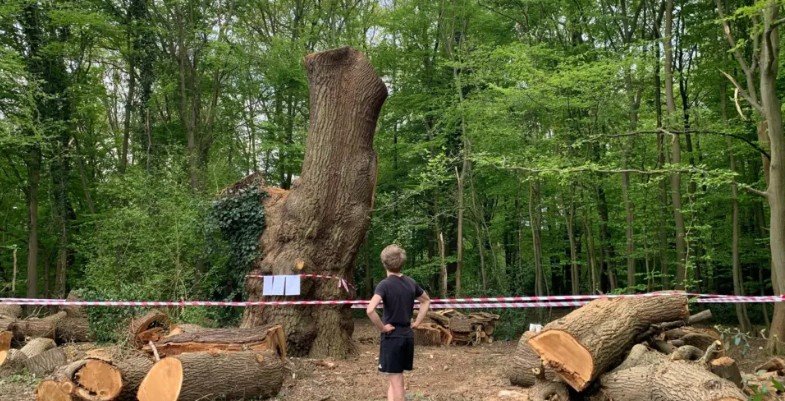The Enfield Oak
A Tree Lost, A Lesson Learned: Why Ancient Trees Deserve Stronger Protection
In early April, one of London’s oldest living oak trees, estimated to be up to 500 years old, was unexpectedly felled in Whitewebbs Park, Enfield.
The ancient oak, with a trunk over six metres in circumference, was a living monument to centuries of history, biodiversity, and natural resilience.
Contractors working for Mitchells & Butlers Retail (owners of a nearby Toby Carvery) cut the tree down after being advised of potential health and safety concerns. But the decision has sparked a wave of public outcry, official investigation, and fresh calls for better protection of veteran trees.
What makes this situation so heartbreaking for those of us in the arboriculture and environmental sector is that this was not just a tree.
This was a lapsed pollard oak, likely a legacy of traditional land management, which had grown into a sprawling, habitat-rich giant. Ancient oaks like this support hundreds of species, from fungi and lichens to birds, bats, and invertebrates. They’re often described as living ecosystems in their own right.
Yet, despite its ecological and cultural value, this tree had no Tree Preservation Order (TPO). Legally, it had no more standing than a sapling on private land. And while the remaining trunk has now been given TPO status in the hopes it may regenerate, the damage is done, and irreversible.
Why This Matters
As professionals in tree management and consultancy, we understand the fine balance between public safety, landowner responsibility, and environmental stewardship. Trees especially large, mature, or veteran specimens must be regularly assessed for risk. However, cutting down an ancient tree should never be a quick or isolated decision.
“I’ve spent my life working with trees, but ancient ones still stop me in my tracks. Their hollow trunks, twisted bark, and weathered crowns aren’t signs of decay, they’re proof of endurance.
These trees have seen more than any of us ever will, and it’s our duty to protect them.
As arborists, our role is to protect, preserve, and manage these living monuments, not just for safety, but for future generations.”
— Simon Rotheram, Managing Director, Beechwood Trees and Landscapes Ltd
What this case highlights is a critical gap in the system: ancient and heritage trees in the UK do not currently have automatic legal protection, even if they are nationally significant. A centuries-old building would be listed and safeguarded. So why not a tree of the same age and importance?
One of our colleagues and contractors from the area had this to say:“I can't believe this has happened. This is a loss of a National Treasure” – Lawrence-Thor Stephen (Thor’s Trees)
See more in his article here:
https://www.thorstrees.co.uk/blog/news-and-updates/old-ancient-oak-tree-cut-down-in-whitewebbs-park/
The Call for Change
The Woodland Trust, among others, is calling for new legislation to protect ancient trees by placing them on a national heritage register, making it a legal requirement to preserve them unless there's an overwhelming and evidenced need for intervention.
At Beechwood Trees and Landscapes Ltd, we fully support this direction. As contractors working with councils, housing associations, schools, and landowners, we specialise in proactive tree management.
This includes detailed surveys, health assessments, risk reports, and management plans that help our clients make informed, responsible decisions long before drastic action is needed.
Ancient trees don’t just need protection from disease or decay, they need protection from neglect, miscommunication, and rushed decisions.
Moving Forward with Respect and Responsibility
Let the Whitewebbs Oak be a powerful reminder of the legacy trees leave behind and the responsibility we all have to care for them.
If you manage public or private green spaces and want to better understand how to protect and maintain your tree stock responsibly, get in touch with our expert team.
Together, we can make sure every tree especially the oldest and most precious gets the care it deserves.

